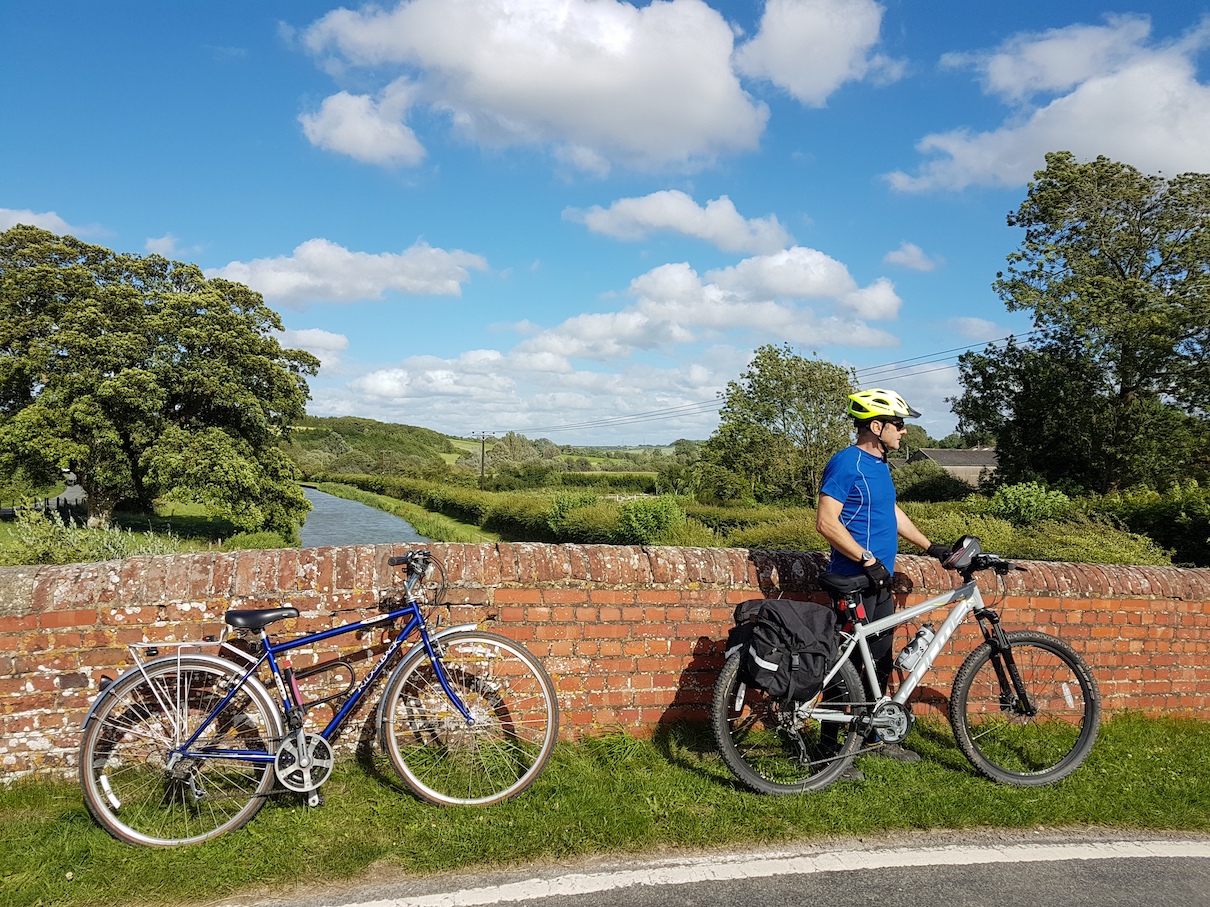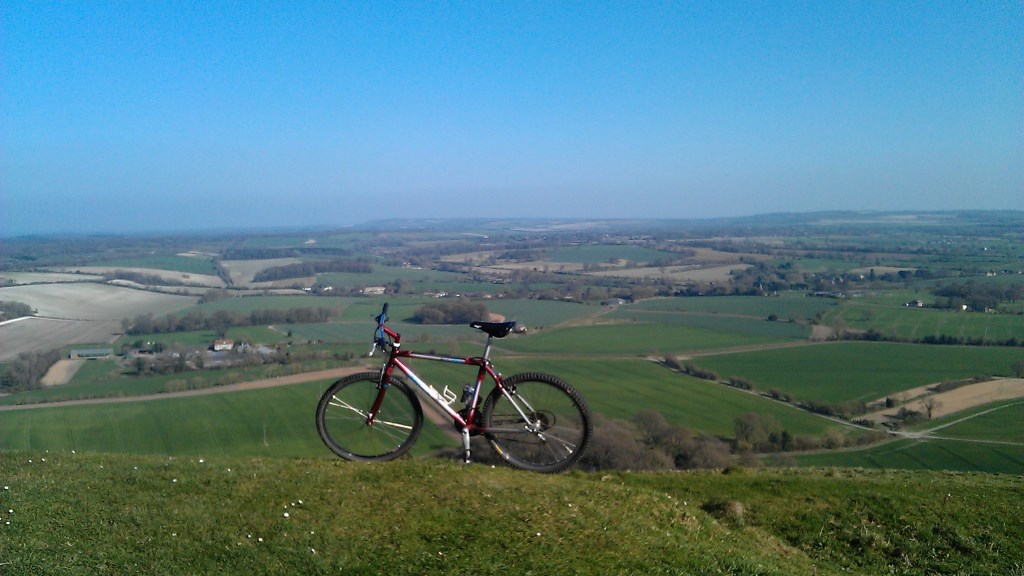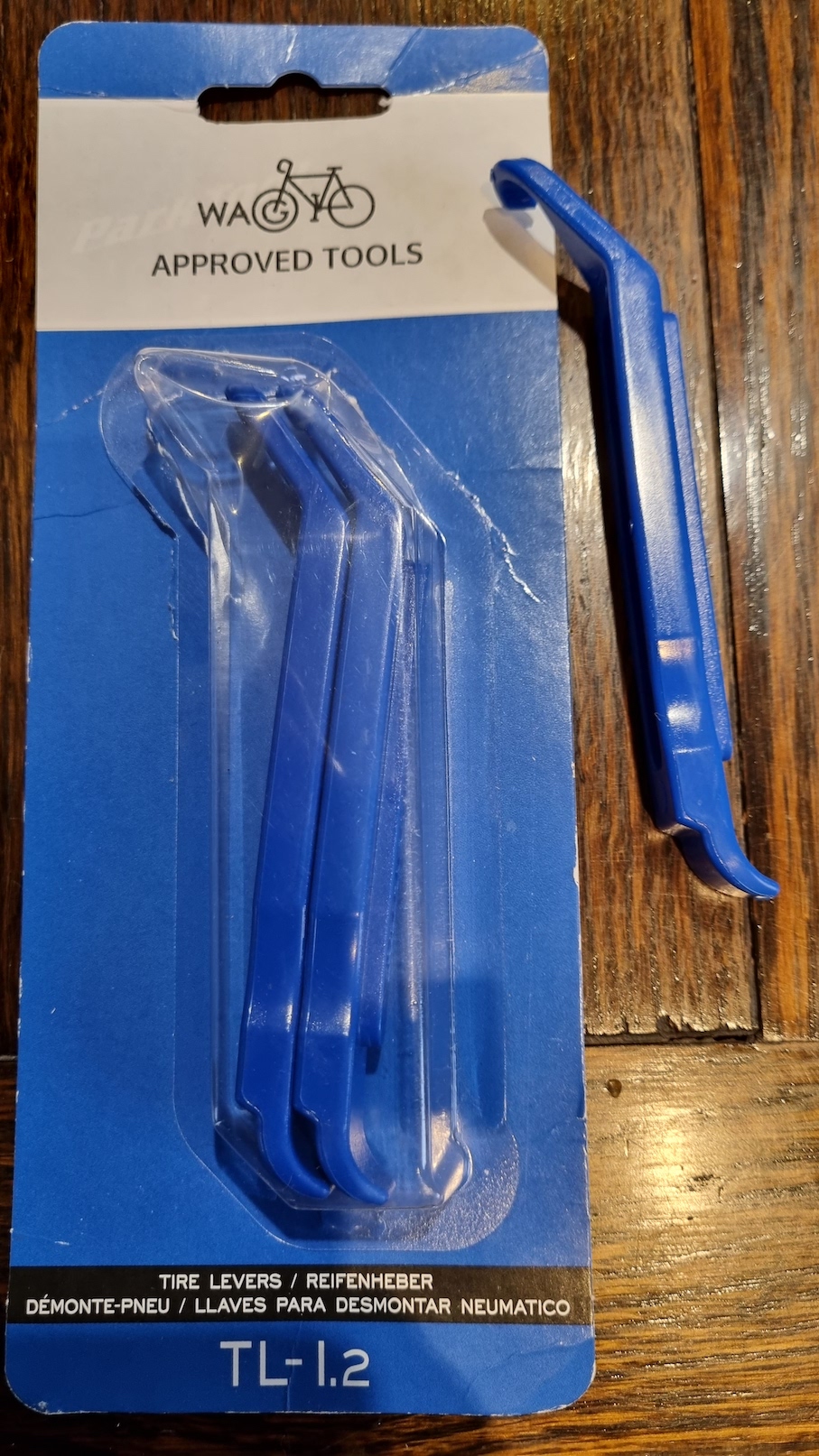
During lockdown, a group of friends in Wexcombe and Grafton (WAG) in the Vale of Pewsey started cycling together. Very much a social and wellbeing group, they often encountered punctures. Trevor, who generally ended up repairing the punctures, decided a user guide for the rest of the cyclists might be useful. There are some very good tips in amongst this very funny article!
WAG Approved Techniques - How to change a bicycle inner tube
First assemble the tools you will need.
● WAG approved tyre levers in a nice mid blue.
● Optional 15mm spanner for those traditionalists with nuts instead of quick release wheels
● Cake
● A selection of swear words
● Plasters
Remove any accessories like Go Pros or Garmins that might be attached to your handlebars. If you will be working on the rear wheel then put the gears into the top gear (the smallest cog) on the back. This makes it much easier to get the wheel in and out later. You can change gear whilst stationary by lifting the back wheel of the bike and rotating the pedals by hand while at the same time moving the gear lever to top gear. If you don’t have three hands then the other option is to change gears once the bike is upside down. However this is considered cheating.
Tip your bike upside down using the approved “Grafton Flick”. To perform a “Grafton Flick” position yourself to the side of the bike. Breathe in using the normal method. Bend over the bike and grasp the two main frame bars one in each hand with thumbs towards the bottom of the bike. Stand up and flick the bike around in your hands so that your thumbs are now upward. Gently sit the bike down on the ground. Take care not to scratch or damage the gear or brake levers while doing so. Now breathe out using the abnormal method.
Check which tyre needs attention. Generally it will be the flat one. If it’s not already flat then now is a good time to make it flat.
There are two common types of bicycle valve. Ordinary normal valves that look like car tyre valves. These are called Schrader. The other type is longer, thinner and bloody irritating. These irritating valves are called Presta valves. Presta valves are irritating because they have a sort of locking nut on the top which you have to loosen to pump them up and let them down.
In my experience pumping them up is irritating (did I mention that?) because attaching the pump usually results in the tyre going down which I find irritating.

To let down an inner tube with a normal valve, take the plastic cap off and press down on the little pin in the middle. Simple.
To let down an inner tube with an irritating valve remove the plastic cap, undo the nut and fiddle about until the tyre goes down.
Now we've got to look at your brakes. There are two types of brakes. Discs and Rim. Rim brakes are the old style with brake blocks that rub on the rim of the wheel. Disc brakes, um, have discs.
If you have discs it is potentially easier, or a potential disaster. My approach is to make sure the brake levers are not in any danger of being touched. Then simply take the wheel out and ignore the brakes. This works well providing you don’t touch the brake lever. If you do touch the brake lever then the brake calliper will close up and the disc pads will come together and you won't be able to get the wheel back in. So don’t touch the brake levers. (did I mention that?). What you are supposed to do is take the wheel out then quickly insert a little metal spacer in the calliper to stop the pads moving. But I don't have one of those spacers, and I guess neither do you. So as I may have mentioned before - don't touch the damn brake levers!
If you have rim brakes then what you are supposed to do is to unclip the cable from the brake calliper so that the brake blocks open right up to let the wheel out. This poses two problems.
First I find clipping the cable in and out is a right pain and sometimes takes longer than the entire rest of the job. Second I have a reputation of forgetting to reconnect the cable which means my victim rides off into the sunset without any brakes. So Instead I recommend if you just let the air out of the tyre you can squeeze the tyre out between the brake blocks without undoing the brake cable.

So,back to the plot.
Undo your wheel. If you have got the irritating quick release wheels then simply struggle with the lever and fiddle around rotating the left and right side of the wheel grippy things until the wheel will come out. If you got nuts then take your spanner and just undo the nuts a little bit.
If it’s the front wheel you are taking out then it should now just lift out. If it wont come out then you probably got those irritating quick release levers so fiddle with those a bit more.
If it’s the back wheel then you have to get covered in oil before it will come out. To get covered in oil pull the derailleur back towards the back of the bike, exposing the little cog so you can simply lift the wheel out stylishly disengaging the cog from the chain at the same time. If the wheel won’t come out then you probably got those irritating quick release levers so fiddle with those a bit more.
You should now have a wheel with a flat tyre in your hand. If you haven't then refer back to the top of this document and start again.
Unscrew the small metal ring holding the valve to the wheel.
Find a flat surface, sit down and eat the cake.
Whilst munching the cake, now is the time to examine your WAG approved tyre levers. You will notice one end has a scoopy bit and the other end has a hook. Place your wheel on a flat surface. With one hand aggressively bend the tyre back over the side of the wheel rim. Work the scoopy end of the tyre lever down in the exposed gap and hook the scoopy end over the inside edge of the tyre. Take care to get the scoopy end only around the tyre rim, and not get the inner tube caught up in the scoop as that will only end in tears.
Pull the WAG approved tyre lever back so that a section of the tyre is pulled up over the edge of the wheel. Now hook the hooked end of the WAG approved tyre lever around one of the spokes to stop the tyre flipping back into position.
It depends what sort of tyre you have as to have much pain your life will be from this point on. If you have a nice fat mountain bike tyre it will be big enough and flexible enough that it will come off relatively easily. If you have skinny tyres then you are in for a fight. Take a second WAG approved tyre lever, choose a spot a little bit further round from the first lever and do the same trick again to pull a second section of tyre over the rim. From this point with a mountain bike tyre you can probably pull the tyre off with just your hands. With the skinny tyre you might have the fight on a bit longer and use the third WAG approved tyre lever.
You should now have one complete side of the tyre rim pulled up over the wheel all the way around. The inner tube should be exposed.
If you didn’t unscrew the ring holding the valve to the wheel earlier then do it now, and please pay more attention in future.

Now is the moment you have been waiting for - it's time to remove the inner tube.
Find the valve and bend the tyre right back and bent over so that the valve can be pulled out of the wheel. If you have normal valves then you don’t have to bend the tyre too far. However if you have an irritating longer valve then you have to bend the tyre further to allow the valve to come out. Now pull out the inner tube all the way around the tyre. It should smell nice and rubbery. You can give it a good sniff if you like that sort of thing.
Spend a few minutes to see if you can see what it was that made the tyre go down. You might pump the old inner tube back up while it is out of the tyre and see if you can feel when the air is escaping. If you do find the leak, then note where it is in relation to the valve and inspect the inside of the tyre carefully or run your fingers round the inside of the tyre to see if there is a thorn or something sticking through the tyre. If you do detect something then make sure you pull whatever it is out before fitting the new inner tube. You can repair your fingers with the plasters after doing this detective work.
It’s time to fit the new inner tube. So it’s a good time to ask one of your colleagues to cycle home and get it for you, while you eat more cake.
Take your new inner tube. Take the plastic cap off the valve, remove the metal ring at the bottom of the valve.
Poke the valve through the hole in the wheel. Loosely fit the metal ring back onto the valve to stop the valve falling out, but not do it up tight at this point as we got a lot of fiddling about to do.
Poke the rubber inner tube into the tyre all the way around. This is fiddly as the inner tube will be ironed flat by the Chinese packaging and the tyre is round so feel free to use a few swear words while you struggle to get it to stay in the right place.
Put the tyre on. If it's a nice chunky mountain bike tyre you can probably just push it back over the rim of the wheel by hand. If it's a skinny tyre then you might have more issues. In this case pull the tyre on the best you can, then use the WAG approved tyre lever to gently pull the tyre back over the rim. Some skinny tyres are real sods so you might need two tyre levers and starting at the points where the tyre crosses the wheel work your way around until finally the damn tyre goes on. During this elegant process make very sure not to pinch the inner tube with the tyre lever as otherwise you will puncture it.
Success! Your tyre is now on. But now you have to make sure the inner tube is inside the tyre and the tyre is even all the way round. This is especially important near the valve because you may have done the metal ring up too tight too early. So make sure the valve is sticking up straight, undo the metal ring on the valve a bit but don’t take it off. Push the valve into the tyre and pinch the tyre close to the valve. Now pump it up just a little bit and see if it looks even all the way round. I am sure it will look perfect.
Don't pump the tyre up too much at this stage.
Refit the wheel. Before you do have a good look at the tyre. Some dozy tyres have an arrow on them as they are supposed to rotate one way only. Gawd knows what difference that really makes at 8mph but it’s something to look for and make sure that the wheel will be rotating in the direction of the arrow when you refit it.
If you have rim brakes then make sure the tyre is quite flat, squeeze the tyre and push it back through the brake blocks.
If the bike has disk brakes then gently slot the disk back into the caliper as the wheel drops in.
If you are refitting the back wheel then you have a bit of extra fun as once again you pull the derailleur back towards the back of the bike, exposing the chain and gently slot the small cog back on to the chain as you slide the wheel back into position. After a while you will really begin to enjoy this.
Fiddle and mess about until the wheel seems to fit nicely in the forks, the brakes look right and the chain is on if appropriate.
Do up the wheel nuts with your spanner. Or if you have those irritating quick release clamp things then spend a few minutes twiddling each side in turn and trying to do up the clamp until you get it tight but not too tight. (is there such a thing as too tight?).
Time to do the inverse Grafton Flick to put the bike back up the right way. This is worth practising so you can show off the technique at parties.
Finally you are ready to fully pump up your tyre. If you don’t know how to pump up the tyre then no amount of words are going to help you so I suggest abandon the bike in the hedge and walk home.
Assuming you do manage to pump up the tyre then now is a good time to do up the little ring on the valve. Then check all the other bits and bobs you have played with including the brakes.
Disk brakes sometimes need a few pulls to get the fluid flowing back the right way.
Reattach your Garmin and Go Pro if necessary.
Leap on to your bike and ride off towards the next puncture.





